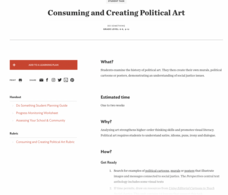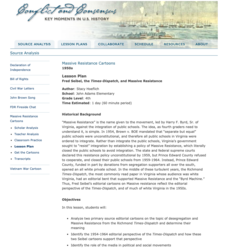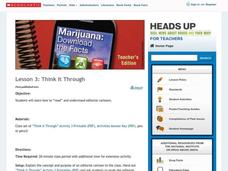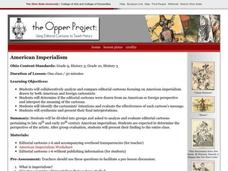Pulitzer Center
The Paradise Papers: A Lesson in Investigative Journalism
The Paradise Papers, a year-long research project from the International Consortium of Investigative Journalism (ICIJ) exposed how political leaders, business people, and wealthy individuals used offshore entities to avoid taxes and hide...
Madison Public Schools
Journalism
Whether you are teaching a newspaper unit in language arts, covering the First Amendment and censorship in social studies, or focusing on writing ethics in journalism, a unit based on the foundations of journalism would be an excellent...
Judicial Branch of California
The Power of the Press: The First Amendment
Was what happened in 1886 at the Haymarket riot a crime or a case of xenophobia? Using political cartoons from the time, young historians consider the role the media played in anti-labor sentiment during the time and how that influenced...
Teaching Tolerance
Consuming and Creating Political Art
A picture is worth a thousand words, but political art may be worth even more! After examining examples of political cartoons, murals, and other forms of public art, class members create their own pieces to reflect their ideals and...
Roy Rosenzweig Center for History and New Media
Fred Seibel, the Times-Dispatch, and Massive Resistance
A instructional activity challenges scholars to analyze editorial cartoons created by Fred Seibel, illustrator for the Times-Dispatch, during the Massive Resistance. A class discussion looking at today's editorial pages and Jim Crow...
Newseum
Decoding an Editorial Cartoon
What advantages do political cartoons have over written editorials? Scholars discuss the topic by exploring editorial cartoons. Working in small groups, pupils analyze an Uncle Sam cartoon and complete a worksheet. As a fun extension,...
University of Pennsylvania
Using Comic Strips to Teach Multiple Perspectives
Scholars view comics from two different perspectives; one paints the Alfred Dreyfus as innocent, while the other portrays the exact opposite. They solve the mystery of what happened by analyzing the source, working in groups, and...
Scholastic
Think it Through
What does the media tell the teenagers about using marijuana? Help class members decipher what they are being told about drug use with a lesson on editorial cartoons, subliminal messages, and critical thinking skills.
Curated OER
Creating a Cartoon
In this journalism worksheet, students learn the guidelines for creating a political or editorial cartoon. Students complete 5 questions which help them plan the purpose, characters and setting for the cartoon. Students then draw the...
Curated OER
Cartoons for the Classroom: Timely vs. Timeless
In this historical events worksheet, students analyze a political cartoon about bank failure and respond to 2 talking point questions.
Curated OER
American Imperialism
Critical analysis skills can be built in a variety of ways. Using editorial cartoons (both domestic and foreign) learners will consider how American Imperialism was perceived during the late 19th century. Critical thinking questions,...
Curated OER
Cartoons for the Classroom: Why is Freedom of Speech a Burning Issue?
In this current events activity, students analyze a political cartoon about the freedom of speech and respond to three short answer questions
Curated OER
Cartoons for the Classroom: College as Concept
In this current events worksheet, students analyze a political cartoon about the college application process and respond to 3 talking point questions.
Curated OER
Cartoons for the Classroom: The Economic Paradox
It's a classic conundrum of economics: voters want jobs, but don't want to spend the money required for businesses to hire. This political cartoon analysis activity has students analyzing this enigma and responding to 3 talking points to...
Curated OER
Immigration
This 3-day immigration study draws on historical trends and current events. A worksheet accompanies initial research on one group's U.S. immigration history, giving opportunity for collaborative learning through sharing findings. Groups...
Curated OER
Editorial Cartoons
Do your classes love reading and drawing cartoons? Middle schoolers read an editorial cartoon from a newspaper. They discuss the cartoonist's topic, audience, and purpose. Next, they brainstorm questions they have about the cartoon and...
Curated OER
The assassination of the Archduke: Exploring Perspectives
Use political cartoons for a multiple-perspectives strategy, as pupils learn about the assassination of Archduke Franz Ferdinand. After an anticipatory discussion, they are split into 2 groups. The class reads a primary source account...
Curated OER
Don't Lose Your Way in the News
Students explore language arts by participating in a newspaper analysis activity. In this journalism instructional activity, students identify how newspapers present stories, who is writing them and how they can obtain...
Curated OER
Cartoons in the Classroom: Cartoon Analysis Worksheet
In this current events worksheet, students analyze political cartoons of their choosing and respond to 12 analysis questions about the cartoons
Curated OER
Cartoons in the Classroom: How Matt Davies Carries a Toon
In this current events worksheet, students analyze political cartoons by Matt Davies. Students respond to 2 talking point questions.
Curated OER
Cartoons in the Classroom: Pitfalls of Democratic Elections
In this current events worksheet, students analyze political cartoons about democratic elections that go bad. Students respond to 3 talking point questions.
Curated OER
Cartoons in the Classroom: Visual Clichés
In this current events worksheet, learners analyze political cartoons featuring the use of clichés. Students respond to 2 talking point questions.
Curated OER
Cartoons in the Classroom: Comforting the Afflicted
In this current events worksheet, students analyze political cartoons about defending those who cannot defend themselves. Students respond to 4 talking point questions.
Curated OER
Cartoons for the Classroom: Don't Get It? You're Not Alone
For this historical events worksheet, students analyze a political cartoon from the 1700's and one from the 1900's . Students respond to 2 short answer questions.

























